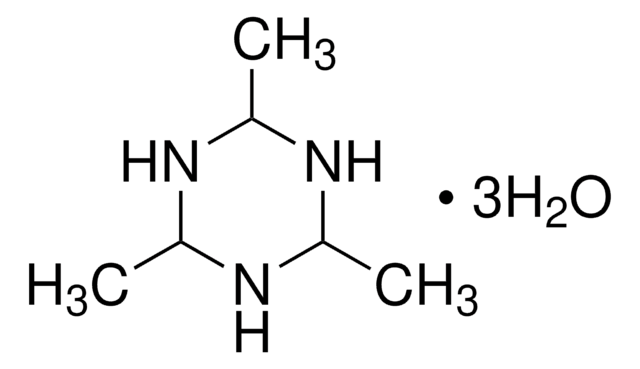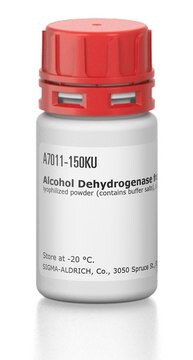1.15640
Aldehyde dehydrogenase
lyophilized, from yeast, pkg of 100 units/vial
Synonym(s):
Aldehyde dehydrogenase
Sign Into View Organizational & Contract Pricing
All Photos(1)
About This Item
CAS Number:
MDL number:
UNSPSC Code:
12352204
EC Index Number:
232-846-3
NACRES:
NA.21
Recommended Products
biological source
yeast
Quality Level
form
lyophilized
specific activity
≥15 U/mg (calculated on the protein content)
packaging
pkg of 100 units/vial
storage temp.
2-8°C
General description
Aldehyde dehydrogenases (ALDH) form a superfamily of phase-I oxidases and are evolutionarily conserved in eubacteria, eukaryotes, archaea, and other living organisms. ALDH is abundantly expressed in the liver and found in hepatic tissue. They are localized to the cytoplasm, mitochondria, endoplasmic reticulum, and nucleus.
Biochem/physiol Actions
Aldehyde dehydrogenases (ALDH) metabolize endogenous and exogenous reactive compounds to maintain cellular homeostasis. This group of enzymes catalyzes the NADP+-dependent irreversible oxidation of aldehydes to form carboxylic acids. ALDH isozymes have broad substrate specificity. Inactivation of ALDH causes cytotoxicity due to substrate accumulation.
Storage Class Code
11 - Combustible Solids
WGK
WGK 3
Flash Point(F)
Not applicable
Flash Point(C)
Not applicable
Certificates of Analysis (COA)
Search for Certificates of Analysis (COA) by entering the products Lot/Batch Number. Lot and Batch Numbers can be found on a product’s label following the words ‘Lot’ or ‘Batch’.
Already Own This Product?
Find documentation for the products that you have recently purchased in the Document Library.
Customers Also Viewed
Kim Shortall et al.
Frontiers in molecular biosciences, 8, 659550-659550 (2021-06-01)
Aldehyde dehydrogenases engage in many cellular functions, however their dysfunction resulting in accumulation of their substrates can be cytotoxic. ALDHs are responsible for the NAD(P)-dependent oxidation of aldehydes to carboxylic acids, participating in detoxification, biosynthesis, antioxidant and regulatory functions. Severe
Endogenous Mitochondrial Aldehyde Dehydrogenase-2 as an Antioxidan
Patel VB, et al.
Liver, 247-259 (2018)
Our team of scientists has experience in all areas of research including Life Science, Material Science, Chemical Synthesis, Chromatography, Analytical and many others.
Contact Technical Service









